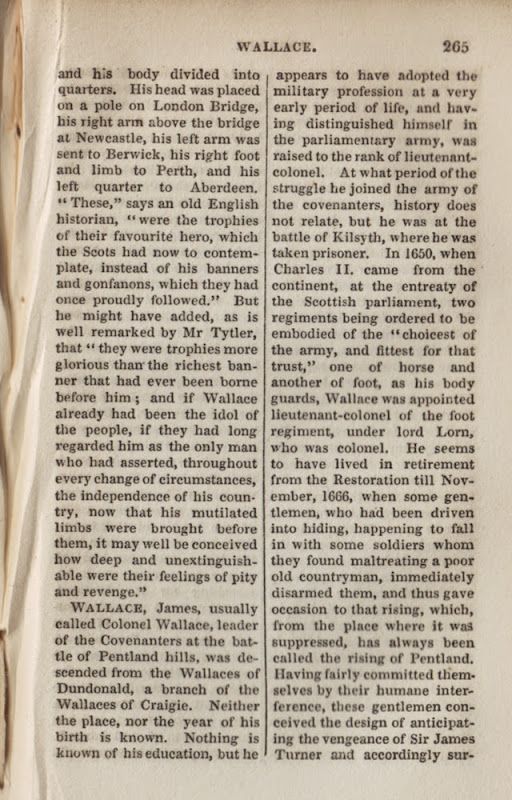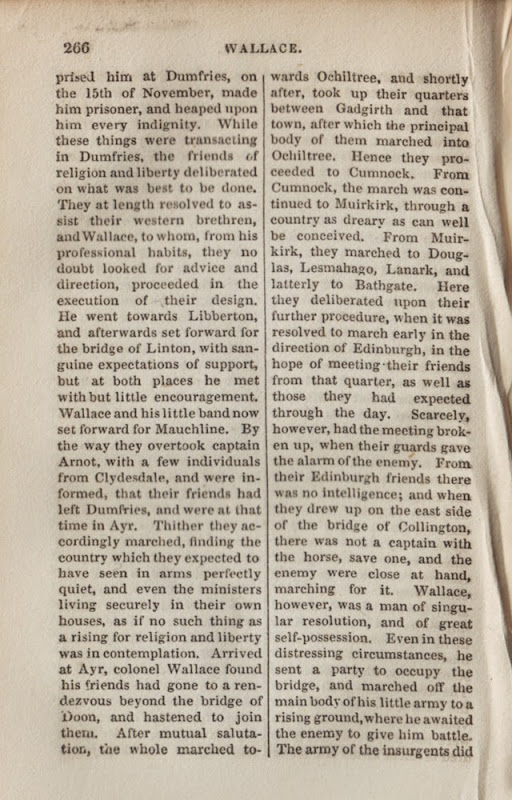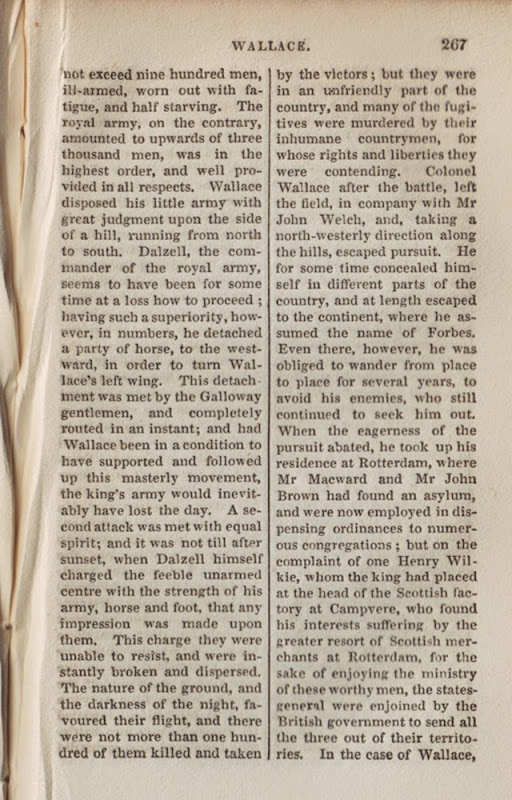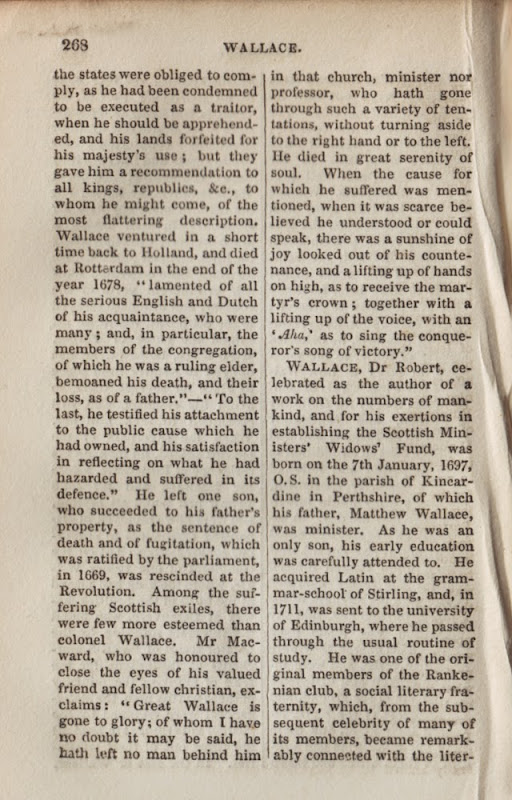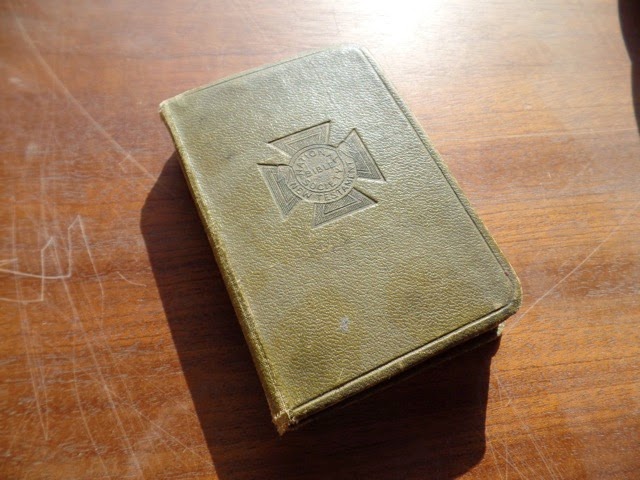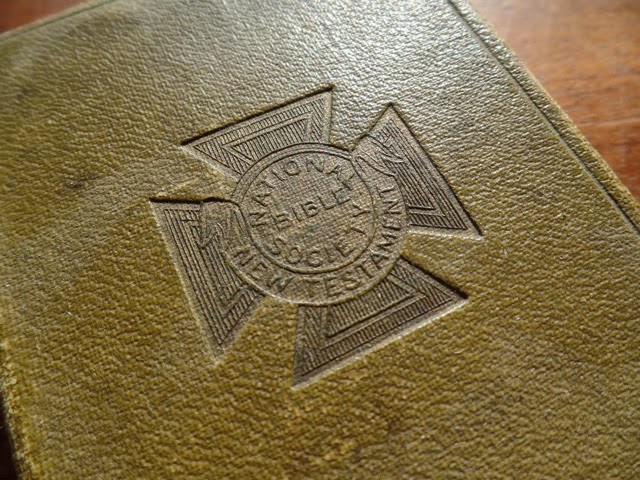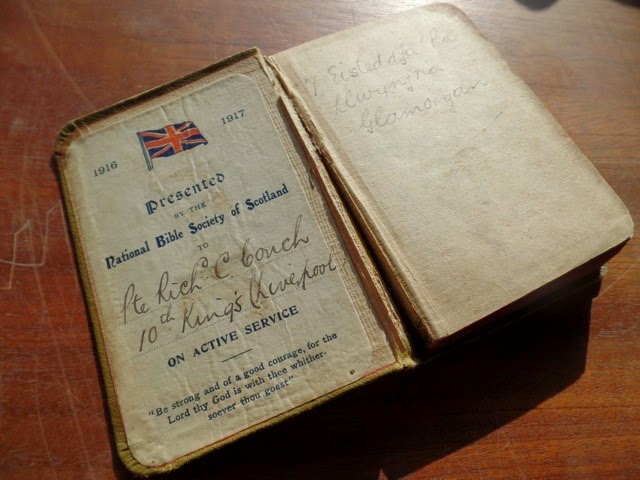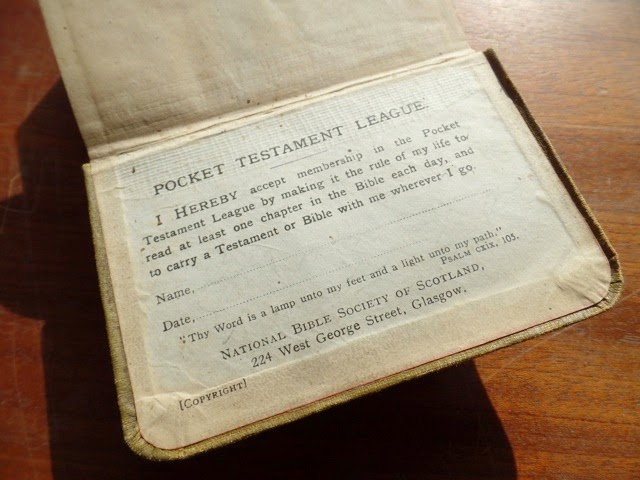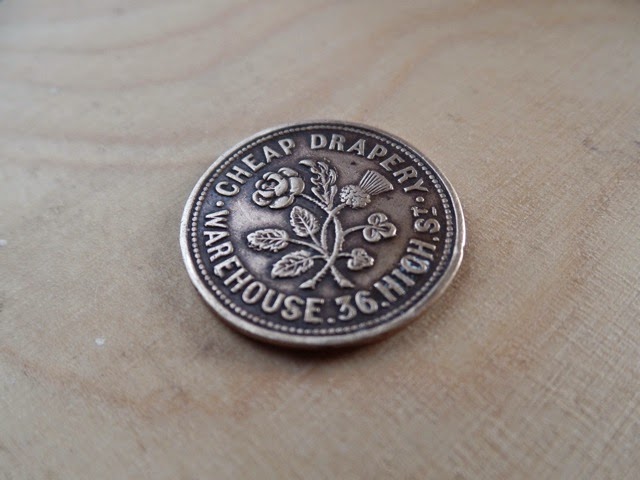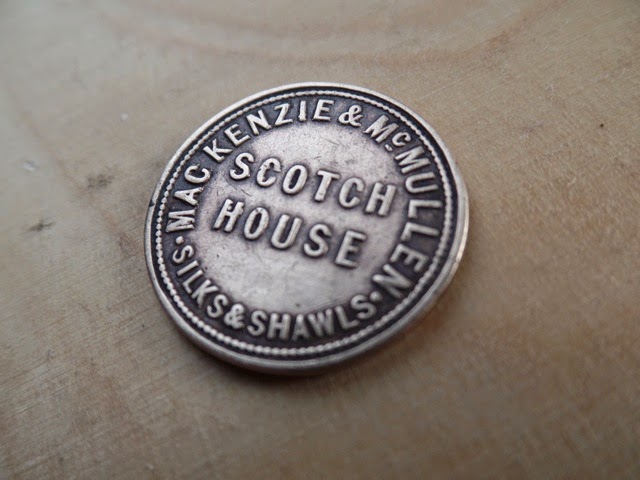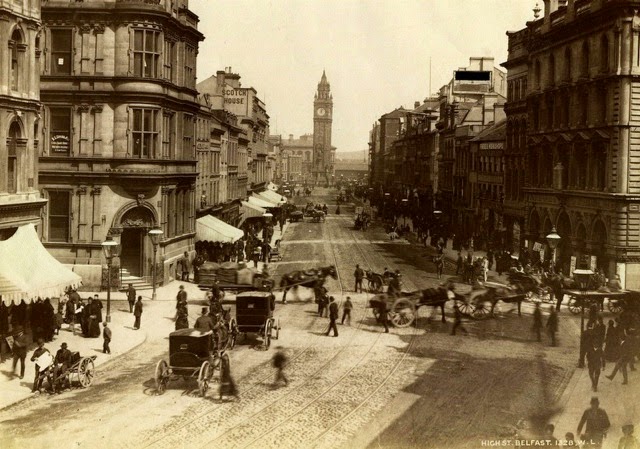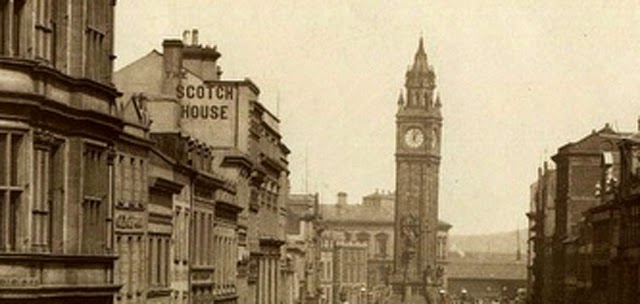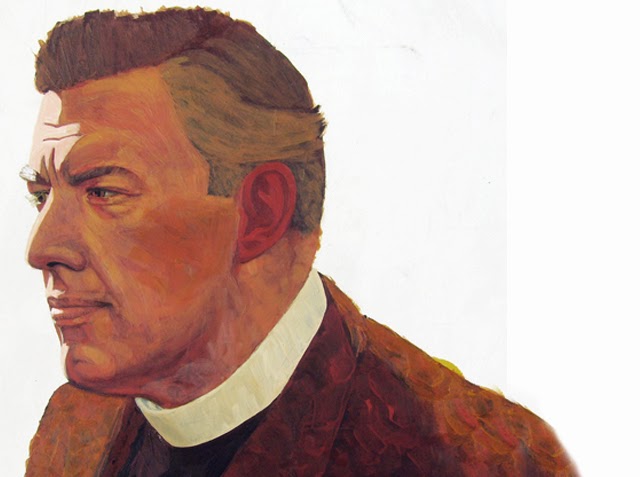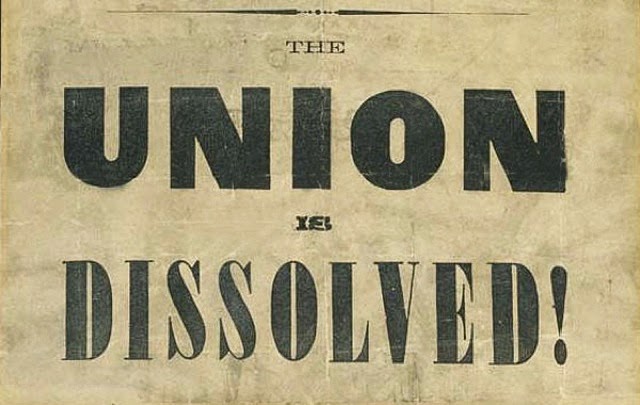I am off to Wicklow tomorrow to give a short biographical presentation about George Francis Savage-Armstrong (1845-1906) as part of the La Touche Legacy Festival of History - The Great War Roadshow (see previous post here). GFS-A is an example of a meaningful cross-border connection, an example of how there are many common experiences across Ireland regardless of province, region or ancestry, right throughout history. He was known as the Poet of Wicklow, yet was enchanted by his mother's County Down origins and of the stories and the Ulster-Scots vocabulary which she brought with her to Dublin, aged 38, when she married Edmund John Armstrong.
The Great War connection is that GFS-A's son, Francis Savage Nesbitt Savage-Armstrong, served with the 1st Battalion of the South Staffordshire Regiment and was killed on 23 April 1917, aged 36. His other son, John Raymond, served with the 4th Leinster Regiment, and his daughter Arabella was a nurse at a military hospital in England and later at Magilligan.
I'll post the entire script here when I get back from the event, as well as an audio recording of an improved version of the script being read by a well-known local voice.
Postscript: I'm very thankful to Rosemary Raughter for the invitation to take part tomorrow, for the initial contact we made with one another via a few blog posts of common interest, and for the opportunity to jointly present the first session tomorrow. I hope that this will be the first of many new bonds which can be developed.
............................................................................................................................
Introduction
There aren’t many poets writing in the Ulster-Scots they learned at their mother’s knee who were in the running to be Poet Laureate. Yet that’s the story of this writer, poet and historian.
George Francis Armstrong was born in Dublin on 5 May 1845. His father, Edmund John Armstrong, was also Dublin-born but his ancestral roots were among the Armstrong clan of the Border Reivers between Gretna and Langholm. George’s major Ulster-Scots inheritance was through his mother Jane. She was the third daughter of the Rev Henry Savage, the Church of Ireland rector of Ardkeen on the Ards Peninsula. (Rev Henry Savage (1772–1815) had served as a Lieutenant in the Downshire Militia, but preached his first sermon in Bangor on 24 November 1793. He moved to Ardkeen in 1794, and married Anne McGuckin in 1798.) Jane was born at ‘Nuns Quarter near Kirkcubbin’ on 30 July 1801, and grew up at Glastry House near Ballyhalbert. Her first 38 years would have been steeped in Ulster-Scots community life. Edmund Armstrong and Jane Savage married at Holywood, County Down on 23 October 1839 and settled in Dublin.
Birth and influence of his mother
George was born in 1845 and was the couple’s third son. From his later writings it’s clear that his mother had an enormous influence upon him and his works -
‘... the present writer is primarily indebted, above all else, to her; and he claims the privilege of paying particular tribute to her memory here in this history of the Savage family; - to her wonderful power of recollecting innumerable facts and incidents; her vivid manner of describing and narrating what she had seen and heard; her warmth and earnestness of feeling; her extraordinary knowledge of character and observation of human life; her wit and humour and exquisite mimicry; her intense love of her own kindred and of the neighbourhood in which she had spent her earliest and happiest years; her hereditary pride; her admiration of everything that was noble and heroic in the history of her ancestry ...’ (from the 1906 edition of The Savage Family in Ulster, p308)
'... Geordie, come hame tae yer mither Come hame tae yer mither, yer ain Come hame tae yer puir auld mither Alane by her blake he’rth-stane! ...'
–– The Prodigal Son', Ballads of Down, p 46.
A posthumous selection of his poems, Poems: National and International was published in 1919 and appropriately began with a piece entitled ‘The Poet’s Address to His Mother’.
Academic Career
George graduated from Trinity College Dublin in 1869 (when the College was founded in the late 1500s, one of the founding Fellows was James Hamilton from Ayrshire, who later brought hundreds and possibly thousands of Lowland Scottish families to the Ards Peninsula, beginning in 1606. This established the Ulster-Scots cultural and linguistic community in which, 200 years later, Jane Savage was raised). The next year he became Professor of History and English Literature of Queen’s College in Cork. During the next thirty years a stream of publications flowed from his pen, inspired by travels to Italy and Greece and also a trilogy of Old Testament stories entitled The Tragedy of Israel. His vocal opposition to Gaelic revival literature brought a high-profile disagreement with WB Yeats. From Armstrong’s surviving papers (which are now held at UCLA in California) it seems that he was a student of Robert Burns’ poetry.
Marriage, and the death of his Mother
On 24 April 1879 George Francis Armstrong married Marie Elizabeth Wrixon from Belfast – her father was rector of St John the Evangelist Parish Church on the Malone Road. It's interesting that his beloved mother was the daughter of a Church of Ireland clergyman, and so was his new bride. But just a few months later, 3rd January 1880, Jane Savage-Armstrong died while at Richmond Hill in Surrey, and was buried in the family plot at Monkstown, County Dublin.
Back to The Ards
The death of his mother seems to have triggered in George a desire to research and record many of the stories of the Ards which she had passed down to him. In 1884 he visited the ruins of Ardkeen Church between Kircubbin and Portaferry, where his grandfather had been rector, where his mother attended as a child, and where so many of his ancestors had lived and were buried. He found it in dire condition, ‘a piteous spectacle’ where ‘rabbits had made their burrows’ and had ‘thrown up quantities of bones from the graves beneath’.
Over the next few years Armstrong, with the Rev Hugh Stowell of Christ Church Ardkeen (which had been built in 1847, and the former church building then abandoned), carried out a major renovation of the church ruins, graveyard and grounds. It may have been these experiences which inspired poems such as ‘The Haunted Hill’:
'... Then dinnae crass Ardkeen at night
Whun winter’s murk and dreary;
‘Mang a’ the lanesome nuiks in Airds
By night there’s nane sae eerie
Thon Castle Hill is haunted groun’
By elves an’ ghaists it’s guarded
There spectre Chieftains pace the fiels
Ower which lang syne they lorded…
…Young Donald laughed with cruel scorn
“Gang hame til Portavogie!
A’m nae the lad tae cower wi’ fear
At curse uv witch or bogie
This night the auld Kirk’s ruin’s wa’
A’ll climb athoot a lather
An’ whaur the conies root the graves
A deed mon’s banes A’ll gather! ...'
–– The Haunted Hill, Ballads of Down, p 22.
In 1888 the scale of his love for his mother’s Ards was revealed when the 400 page volume The Ancient and Noble Family of the Savages of the Ards, was published. It traced the origins of the Savage family in Ulster from their arrival in 1177. Aided by notable historians of the time such as Rev George Hill, Rev William Reeves, Rev Classon Porter and Sir Samuel Ferguson, it’s a superb volume of meticulous genealogy, local history and family anecdotes. Now, as the official chronicler of the Savage family, in 1890 he added Savage to his own surname, becoming George Francis Savage-Armstrong, or G.F. S-A.
'... Some thinks he’s a Savage come up frae Ardkeen
An A dar’ say they’re richt, fur he comes like a frien ...'
–– Mikkel Hayes’s Story: the Spectre of Knockdoo, Ballads of Down, p 199
Ballads of Down, 1901
Having completed the hard task of chronicling the history, he now turned his talents to creative writing. Between 1892 and 1899 Savage-Armstrong took many of these old tales and other lore of County Down and crafted them into a volume of poems, many in the Ulster-Scots speech of the Ards. In 1901, when GFS-A was 56 years old, Ballads of Down was published. As a collection of 92 songs and poems it shows that despite his Dublin birth and academic career, he retained a sound handling of the speech and stories of his mother. The volume was dedicated ‘to the memory of my mother’.
The first Ulster-Scots poem has a familiar Burnsian structure:
'... Amang the lanesome Doonshire hills
Aroon me noo the chaffinch trills
An through the droppin’ daffydills
The bluebells brighten
But ither breezes roon her roam
An ither mountains gird her home
An ither seas wi’ flickerin’ foam
Forenent her whiten ...'
–– Chaffinches, Ballads of Down, p 13.
How did he view the vocabulary and language?
In the ten page Glossary he rejects outright that it is “Irish brogue” and says that:
"... the Downshire dialect, with its variants, is an Ulster development of Lowland-Scottish - principally Ayrshire - brought over by Scottish settlers in the reign of James I... the dialect is more or less marked according to the locality and to the degree of the speaker's education. Some of the peasantry have it so strongly as to be hardly intelligible to a stranger ...".
The dry wit of ‘A Cannae Thole Ye’ is a joy to read even today:
'... Ye may be clivver, may hae won
A wheen o' honour 'nayth the sun
But, whatsaee'er ye've earn'd or done
A cannae thole ye!
Ye may be genial noo and then
Wi' helpless waens an humble men;
But, though ye'd gilt auld Poortith's den,
A cannae thole ye!
Ye may be guid; ye may be great;
Ye may be born tae rule the State;
But, though ye rowl'd the wheels o' Fate,
A cannae thole ye!
Ye may hae drawn yer watery bluid
Frae Noe's sel' that sail'd the Flood;
But, though in Noe's breeks ye stud,
A cannae thole ye!
Ye may be lord o' mony a rood;
Yer smile may mak' a monarch prood;
But, though the De'il afore ye boo'd
A cannae thole ye!
It's nae that ye hae din me wrang;
It's nae A feel a jealous pang
It's jist that, be ye short or lang,
A cannae thole ye! ...'
– A Cannae Thole Ye!, Ballads of Down, p71.
Press Opinions of Ballads of Down
The volume was well received in Ulster, Ireland, Scotland and further afield:
• "the Ulster character and the Ulster dialect have never before found such expression in literature as these delightful 'Ballads of Down.'" - Leisure Hour
• "the spirit which breathes in the national poet of Scotland breathes to a very considerable extent in 'the Poet of Wicklow.'" - Brighton Gazette
• "he is distinctly at his best in the dialect poems, some of which have a homely pathos which is not a little touching." - Liverpool Post
• "there is a genuine charm... and something of Lowland Scotch pith and grit" - Manchester Guardian
• "Mr Savage-Armstrong... is the truest voice that Ulster life has yet found" - Review of Reviews
• "To the Scottish reader these poems will prove especially attractive... that the spirit that pervades these songs is akin to the genius of Scottish poetry will be apparent to every reader... his latest volume shows how deftly he can touch themes of peasant-life in Ulster, and how cleverly he can manipulate the quaint dialect of County Down." - Dundee Advertiser
• "the general excellence of his work will not be questions... his metre is never at fault... to Scotch readers there will be an added interest to his volume from the fact that a number of the poems are in dialect - an Ulster form of Lowland Scotch" - Aberdeen Free Press
• "He shares with Burns a certain swift, unaffected draughtsmanship, and creates for his reader a vivid sense of the natural characteristics of the scene depicted. In his management of the dialect he is wholly admirable" - Irish Times
• "the dialect-verse... has its tender love-strains, its sly humour, and its pathos, which to those who are 'sons of the soil' must make a special appeal" - Northern Whig
Death, burial and memorial edition
He lived at Beech Hurst, Bray, Co Wicklow (which sadly is no longer there) until 1905 and moved to Strangford. GFS-A died aged 61, on 24 July 1906 at his home of Strangford House, a grand home on an elevated site overlooking ‘The Narrows’ towards Portaferry. His coffin was carried by boat across the water, and was buried a few miles further north at the old Ardkeen Church of which he was so fond, in the Glastry Vault on the external wall of the ruined building. Today it is heavily overgrown, below is an illustration.
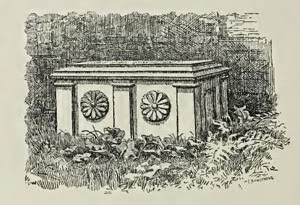
'... It’s no that A believe the Deed
Can ha’nt an’ scaur the leevin
Tae Mon the Blessed Buik haes said
Tae dee but yince is given
An’, haein’ deed, anither lan’
Becomes the sperrit’s centre
It’s bad’ this Airth far’weel, an’ can
Nae mair this Airth re-enter ...'
–– The Elders Experience, Ballads of Down, p 188.
When he died he had just completed an enlarged version of The Savage Family in Ulster, which had just been sent to the printers. It was published in August as a memorial edition; the title page includes a famous quote from John Barbour’s 1375 poem The Brus– ‘All Hail the Flower of Ulster!’ – a reference to the Savage family who fought against Edward Bruce’s invasion of 1315. As Edmund Nugent wrote in the foreword to the 1906 edition:
‘... As he often said, he wished to do for the Ards of the nineteenth century what William Montgomery of Rosemount had done in the seventeenth, and leave to future generations the picture of the localities and people as they existed in his day...'.
Children and the Great War
He and Marie had three children, each of whom served in the Great War
• Francis Savage Nesbitt Savage-Armstrong (died 1917), Lt Col South Staffordshire Regiment
• John Raymond Savage-Armstrong (died circa 1952), Captain 4th Leinster Regiment
• Arabella Guendolen Savage-Armstrong (died circa 1950s) Nurse at Richmond Military Hospital, England / Soldiers Home, Magilligan
There is a memorial to the family inside the newer Ardkeen Church, which reads:
'... To the glory of God and in memory of Edmund John Armstrong, died 12 10 1870, buried Old Cemetery, Monkstown, Co Dublin His wife Jane, daughter of Rev Henry SAVAGE of Glastry died 3/1/1880, buried Monkstown Their sons; Henry Savage died an infant 31/7/1840, buried Mount Jerome; Edmund John, died 24 2 1865, buried Monkstown Their daughter Ann Eliza, married Capt WT CROFT, 65th Regt, died 29/1/1930, buried Tonbridge Their son George Francis Savage-Armstrong [the Poet], died 24/7/1906, buried St Mary's, Ardkeen Their sons, Francis Savage Nesbitt, 1st South Staffordshire Regt Lieut-Colonel, DSO, South Africa 1901-1902, 1st Ypres 1914, Neuve Chapelle 1915, wounded Festubert 16/5/15, killed Arras 23/4/17 John Raymond, Captain Leinster Regt, wounded Hill 60 near Ypres 21/4/15 Their daughter Arabella Guendolen, VAD 1914-18 war, died 20/8/52, buried St Mary's, Ardkeen Port after stormy seas; rest after toil My peace I give unto you ...' (source: History from Headstones.com)
Conclusion
George Francis Savage-Armstrong is sometimes overlooked because he was an academic who lived most of his life far from a traditional Ulster-Scots community – in stark contrast to the celebrated Weaver Poets and the Kailyard novelists and storytellers. However he had a deep emotional connection to the County Down upbringing and influence of his mother, he was aware of his cultural inheritance and of his obligation to respect, record and preserve. His Ulster-Scots poetry - whether ghost story or legend, love story or somber warning – even 100 years after it was written still has the power to amuse, entertain and touch the reader.
............................................................................................................................
Rosemary Raughter gave an excellent presentation on the Wicklow aspects of GFS-A's life, his appreciation of the landscape, his close relationship with his brother Edmund, and his literary inspirations. In the Q&A session at the end, one gentleman asked two questions - one was on the controversy with Yeats and whether GFS-A therefore was not 'a friend of the Celtic people', and also whether GFS-A had written about the 1798 Rebellion. My reply was that in later life, as shown in Ballads of Down, he uses a lot of imagery such as fairies, ghosts, and local legend, so perhaps his attitudes changed over time. On 1798, it is certainly curious that given the volume of tradition in the Ards area, he didn't make any reference in Ballads of Down. Rosemary drew attention to one Wicklow poem where it is mentioned. But perhaps with his grandfather having been an Anglican cleric, and a former Militia man, living in a Rebellion hotbed at Ardkeen (a relatively obscure place, but which was the setting for SR Keightley's novel The Pikemen - A Romance of the Ards of Down, published in 1903), GFS-A was conflicted on the era. I should have pointed towards The Ancient and Noble Family of the Savages of the Ards in which he records a lot of Peninsula history and tradition about the Rebellion.
............................................................................................................................
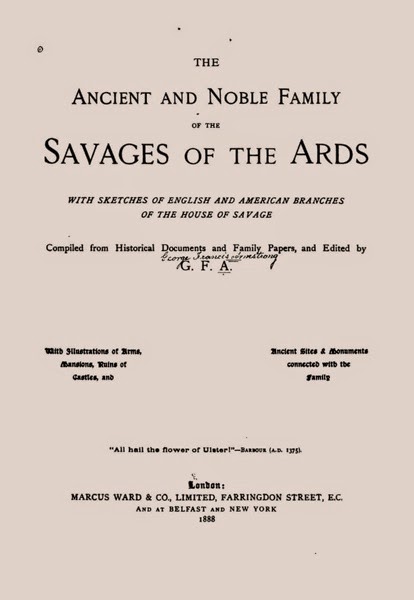
Title page of The Ancient and Noble Family of the Savages of the Ards (1884) 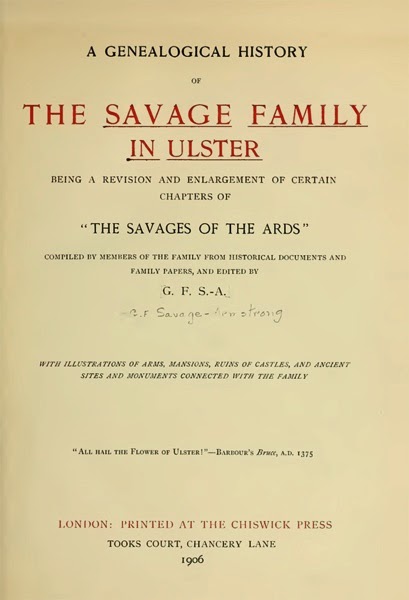
Title page of the revised, posthumous, A Genealogical History of the Savage Family in Ulster (1906) 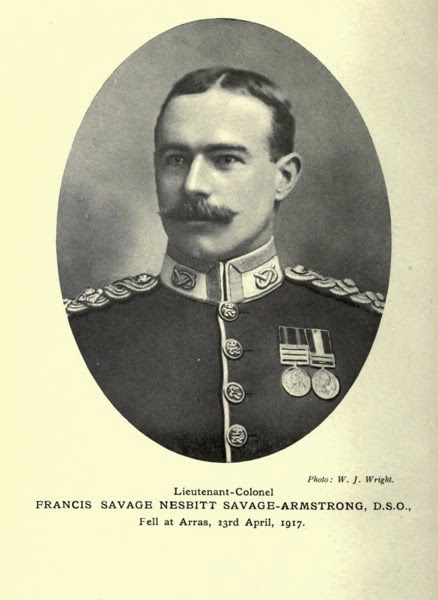
Portrait of Francis Savage Nesbitt Savage-Armstrong
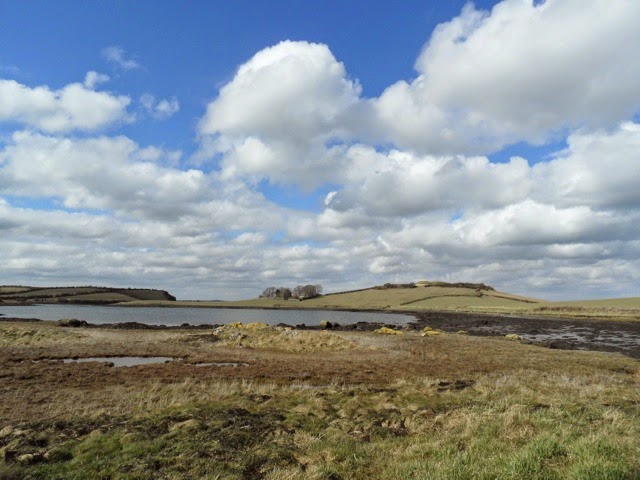
Ardkeen Castle Hill, south of Kircubbin, on Strangford Lough
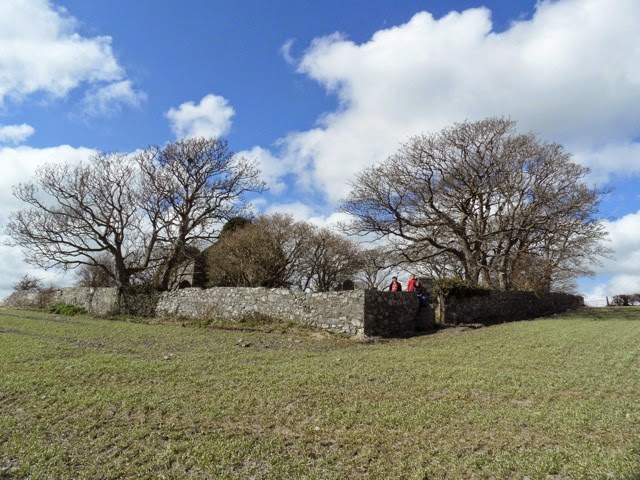 The wall of Ardkeen old church
The wall of Ardkeen old church
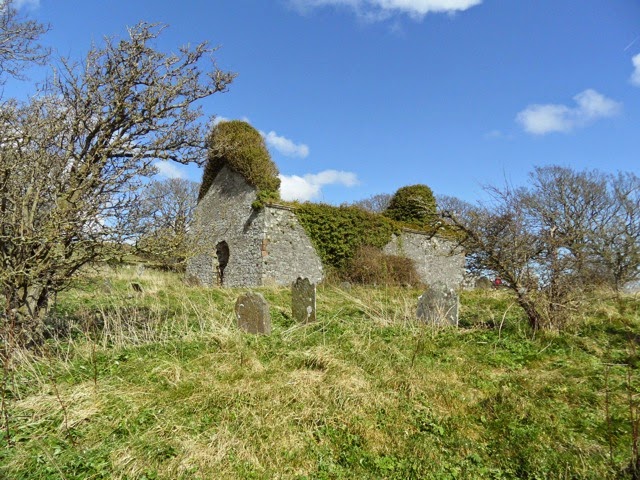 Old Ardkeen church, where Rev Henry Savage was Rector from 1794 (and throughout the 1798 Rebellion). The family's 'Glastry Vault' is under the ivy against the wall.
Old Ardkeen church, where Rev Henry Savage was Rector from 1794 (and throughout the 1798 Rebellion). The family's 'Glastry Vault' is under the ivy against the wall.
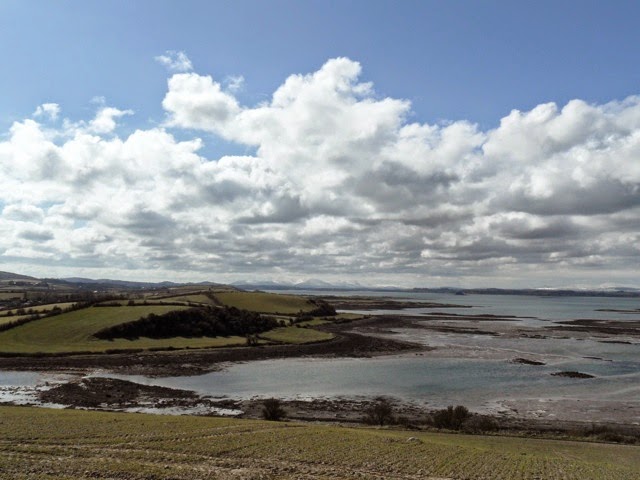
The view from Castle Hill towards the Mournes.
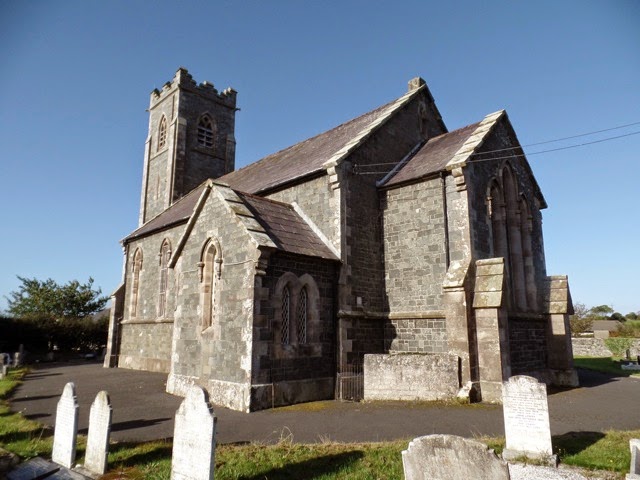
Christ Church Ardkeen, at 'The Quarter' near Cloughey was consecrated on 27 May 1847. The Savage-Armstrong family memorial is inside the church. 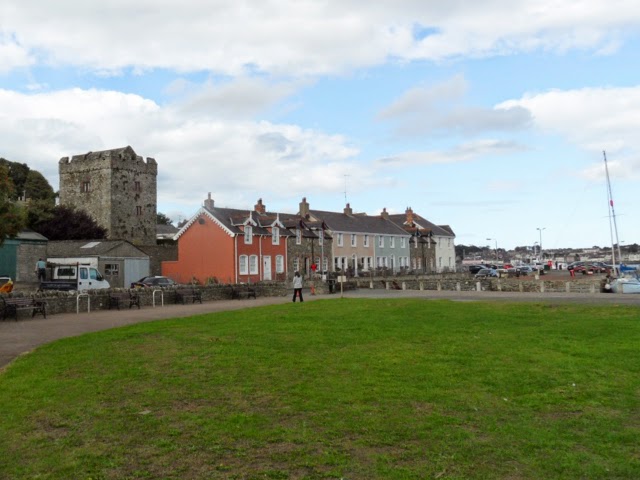
Strangford Castle - the original castle on this site is thought to have been built by the Anglo-Norman Savage family around the late 1400s 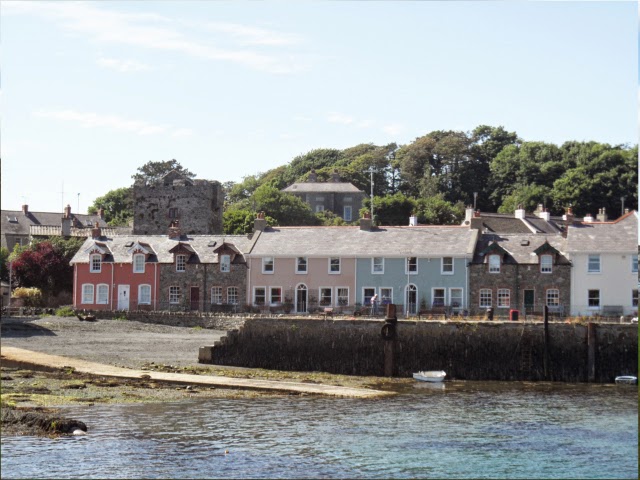
Strangford House, GFS-A's home at the end of his life, overlooks the harbour and ferry quay. 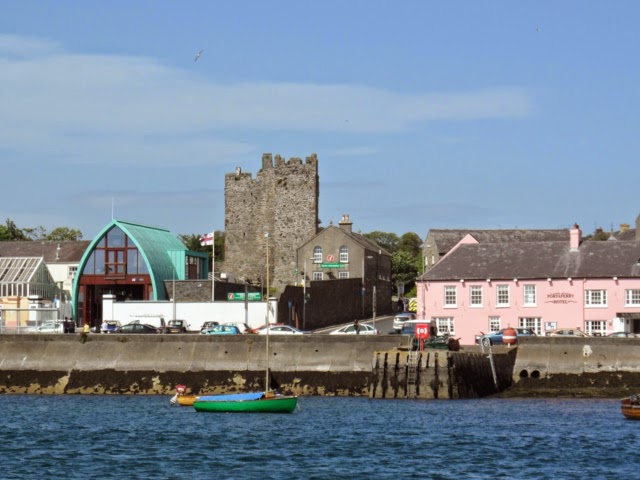
Portaferry Castle was also built by the Anglo-Norman Savage family, in the late 1500s. It was restored by the Scottish Montgomeries in the 1630s, who had married into the Savage family.



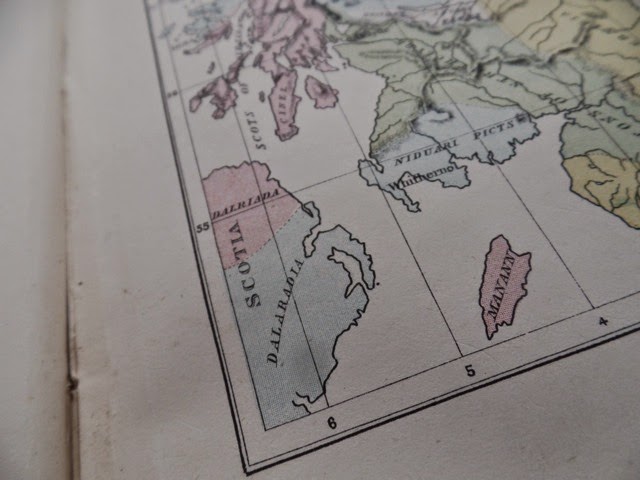
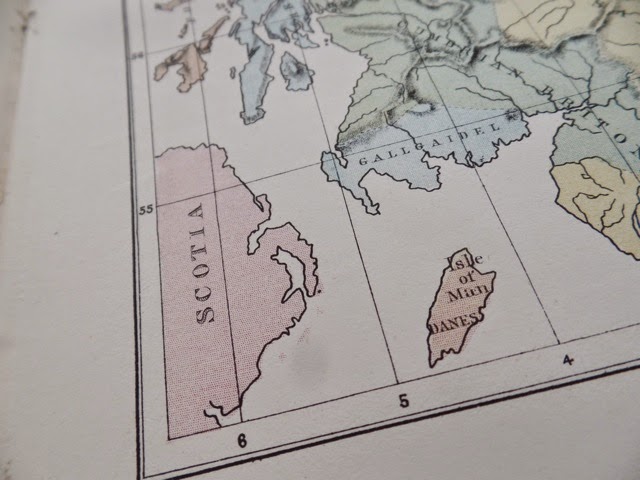





 The wall of Ardkeen old church
The wall of Ardkeen old church Old Ardkeen church, where Rev Henry Savage was Rector from 1794 (and throughout the 1798 Rebellion). The family's 'Glastry Vault' is under the ivy against the wall.
Old Ardkeen church, where Rev Henry Savage was Rector from 1794 (and throughout the 1798 Rebellion). The family's 'Glastry Vault' is under the ivy against the wall.




